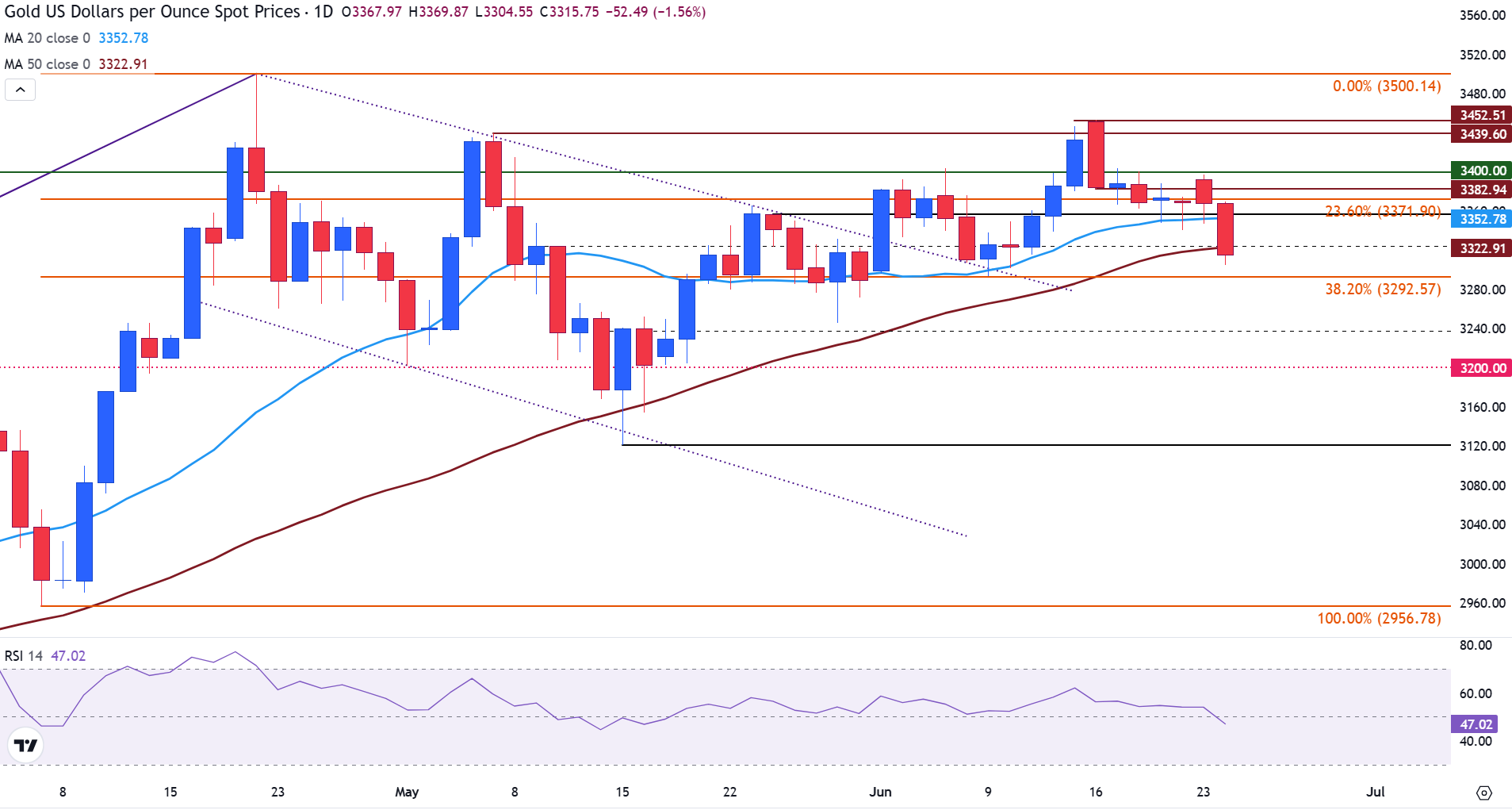Gold falls as Israel-Iran ceasefire lifts risk appetite and Fed Powell testifies
- Gold prices extend losses after Trump announces a ceasefire between Israel and Iran.
- The Federal Reserve (Fed) Chair Powell is scheduled to begin his two-day testimony before Congress, providing insight into the Fed's perspective on monetary policy.
- XAU/USD slides to the 50-day SMA as markets wait for clues on when the Fed may begin to cut rates.
Gold prices are falling on Tuesday as investors flee from safe-haven assets after the announcement of a ceasefire between Israel and Iran.
Risk appetite was lifted after United States (US) President Donald Trump confirmed a ceasefire between Israel and Iran, posting on Truth Social: “THE CEASEFIRE IS NOW IN EFFECT. PLEASE DO NOT VIOLATE IT!”
Despite the apparent breakthrough, Israeli Defense Minister Israel Katz ordered retaliatory strikes after claiming Iran violated the agreement hours after both nations agreed to the ceasefire, allegations that Tehran denies.
With the Middle East conflict entering a fragile pause, attention turns to Federal Reserve (Fed) Chair Jerome Powell’s semiannual testimony before Congress at 14:00 GMT. Traders are closely watching his stance on inflation and the path for rate cuts, with July or September emerging as key potential months for such a move.
Any dovish signal from Powell could renew support for Gold, which typically benefits from lower interest rates due to its non-yielding nature.
Daily Digest market movers: Israel-Iran ceasefire, Fed expectations drive Gold prices
- US President Donald Trump announced the initial ceasefire between Israel and Iran on Monday evening during an address at Capitol Hill, stating that “Stability in the Middle East is essential for global peace.”
- The announcement followed Iranian missile strikes on US bases in Qatar, which were intercepted without casualties.
- The ceasefire has pressured Gold and Crude Oil prices as traders unwind risk hedges tied to potential disruptions in the Strait of Hormuz, a critical chokepoint for roughly 20% of global Oil supply.
- The reduced threat of supply disruption would help lower inflation expectations, a key theme for the Fed, which is facing pressure from Trump to cut interest rates.
- Although markets are pricing in two rate cuts this year, analysts are expecting the Fed to begin easing in September. Any changes to this narrative and these expectations could contribute to Gold’s next move.
- On Monday, Fed Governor Michelle Bowman said she was “open” to rate cuts if inflation continues to ease.
- The remarks echo similar comments from Fed Governor Christopher Waller last Friday. Waller noted in a CNBC interview that “we could do this as early as July.” According to the CME FedWatch Tool, the probability of a rate cut next month is at around 23%, up from 16% a week ago.
- Friday’s release of the Core Personal Consumption Expenditures Price Index (PCE), the Fed’s preferred inflation gauge, will also be key for market direction.
Gold technical analysis: XAU/USD slips toward 50-day SMA support
XAU/USD is trading just above the 50-day Simple Moving Average (SMA) at $3,323 on Tuesday, as prices continue to digest the latest geopolitical developments and assess the Fed's rate path. With prices currently trading near $3,311 at the time of writing, the focus shifts to the $3,300 psychological support level.
A break below this level may expose support at the 38.2% Fibonacci retracement of the April rally at $3,292, followed by the 50% retracement near $3,228.

Resistance aligns at the 20-day SMA around $3,353 and the 23.6% Fibonacci level at $3,372.
A break above $3,400 is needed to revive bullish momentum. The Relative Strength Index (RSI) has fallen to 47.97, indicating weakening upside pressure.
Gold FAQs
Gold has played a key role in human’s history as it has been widely used as a store of value and medium of exchange. Currently, apart from its shine and usage for jewelry, the precious metal is widely seen as a safe-haven asset, meaning that it is considered a good investment during turbulent times. Gold is also widely seen as a hedge against inflation and against depreciating currencies as it doesn’t rely on any specific issuer or government.
Central banks are the biggest Gold holders. In their aim to support their currencies in turbulent times, central banks tend to diversify their reserves and buy Gold to improve the perceived strength of the economy and the currency. High Gold reserves can be a source of trust for a country’s solvency. Central banks added 1,136 tonnes of Gold worth around $70 billion to their reserves in 2022, according to data from the World Gold Council. This is the highest yearly purchase since records began. Central banks from emerging economies such as China, India and Turkey are quickly increasing their Gold reserves.
Gold has an inverse correlation with the US Dollar and US Treasuries, which are both major reserve and safe-haven assets. When the Dollar depreciates, Gold tends to rise, enabling investors and central banks to diversify their assets in turbulent times. Gold is also inversely correlated with risk assets. A rally in the stock market tends to weaken Gold price, while sell-offs in riskier markets tend to favor the precious metal.
The price can move due to a wide range of factors. Geopolitical instability or fears of a deep recession can quickly make Gold price escalate due to its safe-haven status. As a yield-less asset, Gold tends to rise with lower interest rates, while higher cost of money usually weighs down on the yellow metal. Still, most moves depend on how the US Dollar (USD) behaves as the asset is priced in dollars (XAU/USD). A strong Dollar tends to keep the price of Gold controlled, whereas a weaker Dollar is likely to push Gold prices up.

